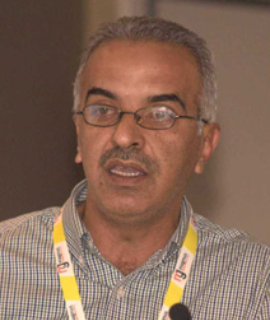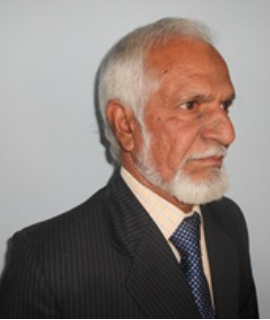Leif Sundheim, Norwegian Institute of Bioeconomy Research, Norway
The Norwegian Scientific Committee for Food Safety has assessed the risk for adverse effects of deoxynivalenol (DON) in different human age groups. DON is the most prevalent mycotoxin in Norwegian cereals, and DON is present in virtually all samples of cereal grain and cereal flo [....] » Read More























































































Title : How science can help to ease up the harsh GMO dispute
Klaus Ammann, University of Bern, Switzerland
If we want to escape this kind of years long regulatory limbo on GMOs, we have to do more than just to deplore the debate full of artificial (or imagined) contrasts and continue in a rather naïve way the war on facts and pseudo-facts. Here two main arguments: First: [....] » Read More
Title : The Social Imperative of Soil Microbiology: Understanding Soil/Plant Interactions for a Better Planet.
Cornelia Butler Flora, Kansas State University, United States
Farmers in settler societies, such as the United States, viewed soil as the medium that held up the plants, despite advice from indigenous people about caring for the soil, agriculture moved west as eastern and southern soils were “worn out”. With the dust storm [....] » Read More
Title : New scenarios for crop plants: TiO2 nanoparticles in sludge-amended agricultural soil
Monica Ruffini Castiglione, University of Pisa, Italy
Beyond all studies published to date on the effects of nanoparticles (NPs) on living organisms, the overall picture of their possible interactions with crop plants and with food chains are not at all clear. These emerging contaminants are becoming a worldwide problem, given th [....] » Read More
Title : Annual ring formation in Scots pine stems as the reaction on seasonal changes in photosynthesis and respiration
Antonova Galina Feodosievna, VN Sukachev Institute of Forest Siberian Branch of Russian Academy of Sciences, Russian Federation
Annual wood increment formation in Scots pine stems was studied simultaneously with the photosynthetic activity of tree crown and stem respiration, steaming of newly formed and the maintenance of living tissue. The formation of annual wood layer was evaluated as the production of [....] » Read More
Title : The effect of Tetraneura ulmi L. galling process on the activity of amino acid decarboxylases and the content of biogenic amines in Siberian elm tissues
Cezary Piotr Sempruch, Siedlce University of Natural Sciences and Humanities, Poland
This report describe the changes in the content of plant biogenic amines (putrescine, cadaverine, spermidyne, tryptamine, spermine and histamine) and key enzymes of their biosynthesis: lysine decarboxylase (LDC), tyrosine decarboxylase (TyDC) and ornithine decarboxylase (ODC) in [....] » Read More
Title : Positive and negative feedback between reactive oxygen species and auxin for adjustment of plant growth under stress conditions
Ivan Paponov, Norwegian Institute of Bioeconomy Research, Norway
During the presentation I will discuss about the mechanism of plant adaptation to abiotic stresses. Specifically, I will address to the observation that different abiotic stresses all seem to modulate plant growth in a way that generates a similar plant phenotype – one that [....] » Read More
Title : Plant intramembrane proteases and beyond
Malgorzata Adamiec, Adam Mickiewicz University, Institute of Experimental Biology, Poland
Proteolysis is considered as a crucial factor determining the proper development of the plant and its efficient functioning in variable environmental conditions. The role of proteases in protein quality control and protein turnover processes is well documented. However, knowledge [....] » Read More
Title : Solanum lycopersicum (tomato) possesses multiple lipoyl synthases capable of increasing lipoylation levels in vivo
Michael Handford, Universidad de Chile, Chile
Lipoic acid (LA) is a functional metabolite with powerful antioxidant capacities present in eukaryotic and prokaryotic organisms. LA is both lipid- and water-soluble, and is the prosthetic group of several key multi-subunit enzyme complexes, including pyruvate dehydrogenase and & [....] » Read More
Title : Modulating effect of low and high temperatures on wheat reaction to cadmium stress.
Natalia Repkina, Institute of Biology Karelian Research Centre of the Russian Academy of Sciences, Russian Federation
The comparative study of wheat plants response to cadmium (Cd) impact in combination with normal (22°C), low (4°C) and high (37°C) temperatures was performed. The similarities and differences of wheat plants responses to these stresses were observed. In particular, pl [....] » Read More
Title : Salt tolerance in rice: plant strategies and genetic improvement.
Elide Formentin, University of Padova, Italy
Salinity tolerance is a complex trait and, despite many efforts to obtain rice plants resistant to salt, few results have been achieved and a deeper understanding of the tolerance mechanisms is needed. By studying two Italian rice varieties with contrasting salt response, we demo [....] » Read More
Title : Plant i-AAA protease controls the turnover of the essential mitochondrial protein import component
Magdalena Opalinska, University of Wroclaw, Poland
Mitochondria are life-essential, multifunctional organelles that are the main sites of ATP production in cell. The bulk of mitochondrial proteins are involved in diverse metabolic pathways, such as the biosynthesis of cofactors like iron-sulphur clusters, and the metabolism of su [....] » Read More
Title : Physiology and metabolism of roots in response to extreme temperatures stress
Moses Kwame Aidoo, Ben-Gurion University of the Negev, Israel
Roots play important role in regulating whole-plant carbon and water relations in response to extreme soil temperatures. Soil temperature is generally lower than that of the air and seasonal fluctuations can occur with depth depending on soil and other factors. These factors can [....] » Read More
Title : Development of leafy head upon microRNA coordination.
Yuke He, Shanghai Institutes for Biological Sciences, China
Leafy head and bulb are a type of agricultural products composed of incurved leaves. Many crops with these products undergo a leaf curvature transition from downward to inward upon aging. In a previous study, we used flat and upwardly-curved leaves of Chinese cabbage (Brassica ca [....] » Read More
Title : Differential oxidative and biochemical responses of tomato and maize leaves to Spodoptera exigua herbivory
Sameera Omar Bafeel, King Abdulaziz University, Science college, Saudi Arabia
Herbivory by chewing insects causes an oxidative burst, characterized by the production of hydrogen peroxide giving rise to both local and systemic responses. Hydrogen peroxide is well known signaling molecule that can activate the antioxidant system to enhance the plant defense [....] » Read More
Title : Manipulation of the starch granule number and morphology in Arabidopsis thaliana.
Joerg Fettke, University of Potsdam, Germany
Starch plays an important role in the plant life cycle. Furthermore, starch is an important source for industrial applications. However, the process of starch granule formation is so far obscure. Neither the physic-chemical mechanisms of starch granule formation nor all necessary [....] » Read More
Title : A Novel CBF from Oil Palm that Regulates Abiotic Stress Response and the Ripening Process through Modulation of the Ethylene Signaling Pathway
Siti Nor Akmar Abdullah, Universiti Putra Malaysia, Malaysia
A novel C-repeat binding factor (CBF) encoding an AP2-domain protein isolated from oil palm fruit (EgCBF3) demonstrated the highest expression level in the mesocarp at the ripening stage. In the mesocarp tissue, expression of EgCBF3 was upregulated by abiotic stresses inclu [....] » Read More
Title : A ecological approximation for the study of Arbuscular mycorrhizal fungi (AMF) sporulation in mediterranean sand dunes
Alberto Guillen Bas, University of Valencia, Spain
The Arbuscular mycorrhizal fungi (AMF) belong to the phylum Glomeromycota. These fungi form an important symbiotic association with most plant species, in such a way that the plant receives inorganic nutrients from the fungus and the fungus obtains sugars from the plant. This int [....] » Read More
Title : Thapsia garganica L. in vitro plants as a new production platform of thapsigargins.
Carmen Quinonero Lopez, University of Copenhagen, Denmark
Thapsigargins are sesquiterpene lactones isolated from Thapsia garganica L., a Mediterranean plant. Thapsigargins are potent inhibitors of the sarco/endoplasmic reticulum Ca+2 -ATPase (SERCA) pump, increasing the cytoplasmic levels of free Ca+2 and inducing apoptosis. This mechan [....] » Read More
Title : How does indole-3-butyric acid induce adventitious root formation in Arabidopsis thaliana thin cell layers?
Laura Fattorini, Sapienza University of Rome, Italy
Adventitious roots (ARs) are post-embryonic roots essential for plant survival and vegetative propagation via cuttings. In different types of explants, the auxin indole-3-acetic acid (IAA), and its natural precursor indole-3-butyric acid (IBA), when applied exogenously, are the m [....] » Read More
Title : Contributions of Plant Tissue Culture to Plant Science
Meltem Bayraktar, Ahi Evran University, Turkey
One of the most important characteristics of plant cells is totipotency. Because of this characteristic, every plant cell possesses the genetic ability to regenerate an entire plant. Plant tissue culture is based on the totipotential characteristic of plant cells. It is the scien [....] » Read More
Title : Comparative evaluation of biochemical changes in tomato (Lycopersicon esculentum Mill.) infected by Alternaria alternata and its toxins (TeA, AOH and AME)
Mukesh Meena, Banaras Hindu University, India
The present study investigates the phytotoxic effect of metabolites produced by phytopathogenic fungi Alternaria alternata. We have evaluated the physiological response associated with defence signalling network and the biochemical and molecular changes relevant to three potent p [....] » Read More
Title : Biotechnologies for ex situ Conservation of botanical important Plant Species and molecular Techniques used for investigating in vitro genetic Stability.
Victoria Cristea, Babes-Bolyai University Cluj-Napoca, Romania
Nowadays, ex situ biodiversity conservation is a very important complementary approach of in situ conservation. Ex situ preservation is based on (i) classical methods (field collection, Botanical Gardens, Arboreta, Seeds banks) and on (ii) modern methods using biotechnologies (in [....] » Read More
Title : Transforming the future of agriculture through synthetic photorespiratory bypass.
Selcuk Aslan, Max Planck Institute of Molecular Plant Physiology, Germany
For a new green revolution to feed the continually increasing population, agriculture productivity has to be significantly improved. Photorespiration represents a big challenge in this respect, since it dissipates energy and leads to the futile loss of CO2, thereby limiting plant [....] » Read More
Title : Identification of transcriptional regulators of cereal grain development and quality
Sofia Kourmpetli, Cranfield Soil and AgriFood Institute, United Kingdom
Temperate cereals, such as wheat, barley and rye, are of great importance for human consumption and animal feed. Even though breeders have been constantly improving the yield potential and quality traits of these major crops, our understanding of the genetic regulatory networks t [....] » Read More
Title : Overcoming the challenges of determining genetic diversity in closely related genotypes that have undergone a genetic bottleneck.
Seanna Hewit, Washington State University, United States
Identification of genetic polymorphisms and subsequent development of molecular markers is important for marker assisted breeding of superior varieties of economically important species. Sweet cherry (Prunus avium L. ) is an economically important, non-climacteric tree fruit [....] » Read More
Title : Sequencing of 260 Citrus Varieties: Linking Genotypes to Phenotypes
Javier Terol, Centro de Genomica, IVIA, Spain
Elucidation of genomic sequences is an essential and necessary first step to identify genetic variants associated with agronomic traits of interest. The Citruseq Consortium, a joint effort developed by public institutions and private companies has sequenced the genomes of 260 cit [....] » Read More
Title : Plant sex: How hot is too hot? Reproductive screening for heat tolerance in cotton.
Susan Yvonne Jaconis, CSIRO Agriculture, Australia
Lacking voluntary locomotion, plants are highly susceptible to the stresses of their immediate surroundings. In particular, abiotic factors such as high temperature and low moisture can have adverse effects on cotton (Gossypium spp.) including negative effects on plant growth, de [....] » Read More
Title : Improving the efficiency of wheat and triticale androgenesis: the starch story.
Magdalena Szechynska Hebda, Institute of Plant Physiology, Polish Academy of Sciences, Poland
Androgenesis is an important tool for plant genetics and breeding, since androgenic embryos can germinate into completely homozygous doubled haploid plants. The stress-induced reprogramming of microspores precedes the induction of andogenesis. Most of the genes identified to be d [....] » Read More
Title : There is far more to underutilised cereals than meets the eye
Acga Cheng, University of Malaya, Malaysia
The genetics and biology of three current trending underutilised cereal crops; namely amaranth, quinoa and teff will be discussed. The specific climate resilient traits possessed by each of these cereal crops will also be discusssed, providing an in-depth understanding of their g [....] » Read More
Title : Fragrant plants used as air fresheners in private households
Henrik Toft Simonsen, Technical University of Denmark, Denmark
Direct assembly of multiple linear DNA fragments via homologous recombination, a phenomenon known asassembly was recently introduced as a technology for transformation of the moss Physcomitrella patens1. This technology has enable us to establish several sesquiterpenoid-prod [....] » Read More
Title : Integrated analysis of phenome, genome and transcriptome of hybrid rice uncovered multiple heterosis-related loci for yield increase
Yeyun Xin, China National Hybrid Rice Research and Development Center China, China
Hybrid rice is the dominant form of rice planted in China, and its use has extended worldwide since the 1970s. It offered great yield advantage and has contributed greatly to the world’s food security. However, the molecular mechanism underlying heterosis have remailed a my [....] » Read More
Title : Targeting chloroplast bicarbonate transporters BicA and SbtA to chloroplasts of Nicotiana for enhanced CO2 fixation
Sandhya Mehrotra, Birla Institute of Technology and Science Pilani, India
In C3 plants, the photorespiratory process that occurs because of the oxygenase activity of the primary CO2 capturing enzyme Ribulose 1,5 bisphosphate Carboxylase/Oxygenase (RubisCO) renders majority of our crop plants poor in terms of productivity. A persistent lower CO2&nb [....] » Read More
Title : Using genomic repeat abundance and cytogenomic approaches to infer phylogenetic relationships in Caesalpinia sensu lato (Fabaceae). Gustavo Souza
Gustavo Souza, Federal University of Pernambuco Bioscience Center, Brazil
Brazil is a mega-diverse country and has one of the richest floras in the world with about 32,360 species of vascular plants, of which 18,082 are endemics. Among the taxa well represented in its flora, the Leguminosae family (Fabaceae), the third largest family of flowering plant [....] » Read More
Title : Tightly controlled expression of bHLH142 is essential for timely tapetal programmed cell death and pollen development in rice
Rachel Swee Suak K, Academia Sinica, ABRC/BCST, Taiwan, China
Male sterility is important for hybrid seed production. We previously showed that knockout of bHLH142 in rice (Oryza sativa) causes pollen sterility by interrupting tapetal programmed cell death (PCD) and bHLH142 coordinates with TDR to modulate the expression of EAT1. In this st [....] » Read More
Title : Increasing of secondary metabolites against malaria by mutagenesis
Kikakedimau Nakweti Rufin, Regional Center of Nuclear Studies of Kinshasa, Congo
Malaria is one of the most important health problems in tropical and subtropical regions. The estimated clinical cases for WHO were 216 million in 2010, approximately disease, mainly children under 5. A major obstacle to malaria control is the emergency and spread of antimalarial [....] » Read More
Title : Secretory structures of the leaves of Hibiscus sabdariffa Linn. (Malvaceae)
Yougasphree Naidoo, School of Life Sciences, South Africa
Plant secretory structures are known for their role as phytochemical factories, and this character has been exploited by mankind for many centuries. More recently, however, medicinal plants have received considerable scientific interest, for the investigation of chemical principl [....] » Read More
Title : Medicinal Plants and Indigenous Knowledge for Well-Being of Local People in Some Areas of Southern Ethiopia.
Mathewos Agize Ante, College of Natural and Computational Sciences, Wolaita Sodo University, Ethiopia
The traditional management, conservation and sustainable use of plant biodiversity in and around home gardens and the indigenous botanical knowledge in Loma and Gena Bosa districts (weredas) of Dawuro Zone, Southern Ethiopia has played an important role in conservation, sustainab [....] » Read More
Title : Meta-Analysis of Economic Indicators in Developing Genetically Modified (GM) Cotton
Julian Witjaksono, The Assessment Institute for Agricultural Technology of Souhteast Sulawesi, Indonesia
Today’s transgenic cotton are rapidly adopted by farmers around the world. Rising the area of growing GM cotton mostly derived from the yield and income gain. Both transgenic cotton and its counterpart in terms of profit gain are affected by yield, seed cost, pesticide cost [....] » Read More
Title : RNA spray fights fungus
Aline Koch, Justus Liebig University, Germany
Meeting the increasing food and energy demands of a growing population will require (the development of) developing ground-breaking strategies that promote sustainable plant production. RNA interference has emerged as a powerful genetic tool for scientific research. The demonstra [....] » Read More
Title : Effects of CO2 enrichment, high photosynthetic photon flux density and ammonium supply on growth and development of Nicotiana benthamiana used as a transient expression system for influenza virus hemagglutinin
Lingling Shang, The Faculty of Agriculture and Food Sciences, Laval University, Canada
Plants are now proven production hosts for biopharmaceuticals and extensive research has been done over the last decade to develop molecular tools for recombinant protein yield improvement. Despite major advances, little is known about the effects of basic environmental parameter [....] » Read More
Title : Linking Plant Demography, Ecological Dynamics And Population Genetics Across Space And Time
Nahaa Miqad Alotaibi, Swansea Universit, United Kingdom
Connectivity between populations is vital to the survival of extinction-prone plants, including those at risk from local environmental change, as well as pests and pathogens, with globally important implications for applied plant ecology. The metapopulation concept has become the [....] » Read More
Title : The movement of Chlamydomonas reinhardtii in response to light is mediated by abscisic acid
Layla Al Hijab, West of England Universtiy, United Kingdom
The phytohormone abscisic acid (ABA) regulates plant responses to various abiotic stresses and diurnal rhythms that alter their water status. Sequencing of the Chlamydomonas reihardtii genome has shown that this flagellate, motile, freshwater, photosynthetic green alga [....] » Read More
Title : Stability of resistance to Fusarium head blight and Fusarium toxin accumulation in winter wheat lines over different environments.
Tomasz G, Plant Breeding and Acclimatization Institute NRI, Poland
Fusarium head blight (FHB) resistance of advanced winter wheat breeding lines was evaluated for three year in two locations (six environments). Lines were selected from breeding programs of Polish breeding companies based on their increased FHB resistance. They did not contain an [....] » Read More
Title : The p24 protein of Citrus leprosis virus C (CiLV C) is a multi-pass transmembrane protein exposing N cytoplasmic-C lumen topology
Mikhail Oliveira Leastro, Instituto Biologico de Sao Paulo, Brazil
Citrus leprosis, caused by Citrus leprosis virus C (CiLV C), is considered one of the major viral diseases of citrus in Brazil. Currently, the Brazilian state of São Paulo is the largest producer of orange juice and an estimated annual cost around U$ 80 million i [....] » Read More
Title : Effects Of Artificial Coelux Light On Plants Growth
Polzella Antonella, University of Molise, Italy
The visible light is an important environmental factor for promoting plants growth and development. Plant pigment molecules, such as chlorophyll and carotenoids, absorb light mainly in the wavelength range of 650-700 nm (red light) and 460-480 nm (blue light) of the electromagnet [....] » Read More
Title : Reaction of winter triticale breeding lines to Fusarium head blight and accumulation of Fusarium metabolites in grain in two environments
Wisniewska Halina, Institute of Plant Genetics Polish Academy of Sciences, Poland
Fusarium head blight is a disease of cereals caused by fungi of the Fusarium genus. These fungi produce toxic metabolites - mycotoxins. Head infection by Fusarium leads to kernel infection and accumulation of mycotoxins in grain. Resistance to Fusarium head [....] » Read More
Title : Taxonomy of plants in phylum using UV fingerprints and robust chemometrics
Costel S, Babes-Bolyai University Cluj-Napoca, Romania
The increasing use of plant based treatments requires a fast, easy and cheap technique in order to verify the quality and authenticity of the products. In this study the UV-Vis spectrometry was applied on 42 commercially available hydro-alcoholic herbs extracts. The UV-range was [....] » Read More
Title : Application of TaqMan probes to study the expression kinetics of celiac disease-related toxic epitopes and their presence in the gDNA of contrasted spelt accessions
Benjamin Dubois, Walloon Agricultural Research Center (CRA-W), Belgium
Gluten is the water insoluble protein fraction found in the flour of several cereals such as wheat and spelt. Its ingestion is responsible of celiac disease (CD) in genetically predisposed individuals (1-2% of the human population). Alpha-gliadins are a class of proteins of the g [....] » Read More
Title : Abiotic stress tolerance in perennial grasses recommended for the management of dry and degradated areas.
Elzbieta Kochanska Czembor, Plant Breeding and Acclimatization Institute, Poland
Permanent grassland are a source of healthy forage for a large group of ruminant animals. They also serve to conserve biodiversity, reduce environmental pollution, including nitrogen oxide and sulfur in the air. They can contribute to the agro ecosystem sustainability by reducing [....] » Read More
Title : AtAIRP2, an Arabidopsis RING E3 Ubiquitin Ligase, Positively Regulates ABA- and High Salinity-mediated Seed Germination by Stimulating ATP1/SDIRIP1 Turn-over
Woo Taek Kim, YONSEI UNIVERSITY, Korea, Republic of
A systemic network of proteolytic regulation via the ubiquitin-26S proteasome system plays significant roles in environmental adaptation and hormone signal transduction in plants. The abscisic acid (ABA) signaling is an essential pathway plants to survive against the abiotic stre [....] » Read More
Title : Functional characterization of ABC transporters in chloroplast
Prashanth Tamizhselvan, Masaryk University, CEITEC MU Czech Republic, Czech Republic
Stress in plants is caused by sudden and restrictive changes in their environment, which disrupts the plant homeostasis and leads to worldwide yield losses. The deleterious effects of stress on plants physiology cause growth retardation, reduced metabolism and altered photosynthe [....] » Read More
Title : Transcriptome analysis of resistant and susceptible sweetpotato cultivars infected with root-knot nematode Meloidogyne incognita.
Yun Hee Kim, Gyeongsang National University, Korea, Republic of
Nematodes are one of the major limiting factors in sweetpotao production. Root-knot nematodes (RKN, Meloidogyne spp.) are widely distributed and economically important sedentary endoparasites of agricultural crops and they may inflict significant damage to field grown s [....] » Read More
Title : Phytochemical composition of essential oil of Croatian endemic species Centaurea tuberosa Vis
Nada Bezic, University of Split, Croatia (Hrvatska)
The genus Centaurea L. is very important genera of Asteraceae family, with many local endemic species. According to Flora Croatica database (http://hirc.botanic.hr/fcd) described 88 Centaurea species, of which 30 is the endemic. The investigated Centaurea [....] » Read More
Title : Evaluation of cultural and wild oat varieties for selected traits affecting the quality of human nutrition.
Havrlentova Michaela, Research Institute for Plant Productio, Slovakia (Slovak Republic)
Present use of oats in making products for human nutrition mostly depends on nutritionally valuable compounds of oat grain. The aim of our research was to create a set of oat genotypes with a high variability of quality parameters and to characterize these genotypes for the prese [....] » Read More
Title : Identification and classification of U-box E3 ligases in barley and their responses to drought stress and fungal infection
Seok Keun Cho, YONSEI UNIVERSITY, Korea, Republic of
An important way of plant defense against environmental and pathogen stresses is exploiting a controlled protein turnover pathway, the ubiquitin proteasome system (UPS). E3 ligases are key enzymes that play a central role in target determing by the UPS. Recently, it has been defi [....] » Read More
Title : The role of antioxidant mechanisms in the tolerance of the Negev desert extremophyte, Anastatica hierochuntica, to abiotic stress
Prasanna Angel Deva, Ben Gurion University of the Negev, Israel
Investigation of stress-tolerant plants is crucial for understanding how plants can tolerate multiple abiotic stresses in the field. The extremophyte desert relative of Arabidopsis thaliana, Anastatica hierochuntica, is tolerant to several abiotic stresses. Because the secondary [....] » Read More
Title : Transcriptome Profiling of Coffee (C. arabica L) Seedlings Irrigated with Diluted Sea water.
Kebede Mesfin Haile, Kangwon National University, Korea, Republic of
Salinity is one of the important abiotic stress factors that limit plant growth and crop production. This research aimed to generate information about the gene expression of coffee seedlings under salt stress conditions and thereby to identify salt responsive genes. The treatment [....] » Read More
Title : Comparison of winter wheat and triticale genotypes for high callus induction and plant regeneration from mature embryo cultures. Lidia Kowalska
Lidia Kowalska, Plant Breeding and Acclimatization Institute, Poland
Triticale and wheat belong to the three most important cereal crops of the world and is grown under a wide variety of climatic and agricultural conditions. These plants are the most common species of food and feed crops and it is a fundamental nutrient source of human calories wo [....] » Read More
Title : The use of modern physical and chemical methods for identifying adaptation genotypes Prunus Cerasus L
Motyleva Svetlana Mikhailivna, FSBSI ARHIBAN, Russian Federation
A comprehensive approach to the study of the resistance mechanisms as part of plant physiology and biochemistry. Anatomical and morphological features of leaes as a factor of passive immunity. A statistical genetics approach in the study of the structure of variability of bioch [....] » Read More
Title : Mineral composition and antioxidant activity of forest plants
Paulina Drozdz, Forest Research Institute, Poland
Heather (Calluna vulgaris) and wild berries (Vaccinium myrtillus L., Vaccinium vitis-idaea L.) are dominant species of forest shrubs growing in Poland. They are rich source of bioactive compounds such as flavonoids, phenolic acids, anthocyanins, stilbenes, tannins, sugars, essent [....] » Read More
Title : Immunogenicity of GP4 and GP5 Recombinant proteins of Porcine Reproductive and Respiratory Syndrome Virus Expressed in Transgenic Plants.
Chul Han An, Korea Research Institute of Bioscience and Biotechnology,, Korea, Republic of
Porcine reproductive and respiratory syndrome virus (PRRSV) is one of the most economically significant pathogens in the global swine industry due to reproductive disorders and growth retardation. Current vaccines against PRRSV rely on the use of an attenuated-live virus, but the [....] » Read More
Title : Response of kidney bean and pea plants to low temperature stress under polyamines treatment and its role to productivity
Jurga Jankauskiene, Nature Research Centre, Lithuania
Temperatures below the optimal for plant growth and development influence a reduction in growth rate, stem elongation, leaf expansion and stomata movements, and cause changes in principal physiological and biochemical processes and thus reflect the plant growth and productivity ( [....] » Read More
Title : Identifying and characterising putative aldose 6-phosphate reductases in Arabidopsis thaliana
Michael Handford, Universidad de Chile, Chile
In Rosaceae (apple, stone fruits) and Plantaginaceae (plantain) species, sugar alcohols like sorbitol are phloem-translocated and allow more efficient use of carbon, act as compatible solutes in abiotic stress (cold, drought, salt) and facilitate boron mobilis [....] » Read More
Title : Taxonomy of plants in phylum using UV fingerprints and robust chemometrics
Costel Sarbu, Babes-Bolyai University Cluj-Napoca, Romania
The increasing use of plant based treatments requires a fast, easy and cheap technique in order to verify the quality and authenticity of the products. In this study the UV-Vis spectrometry was applied on 42 commercially available hydro-alcoholic herbs extracts. The UV-range was [....] » Read More